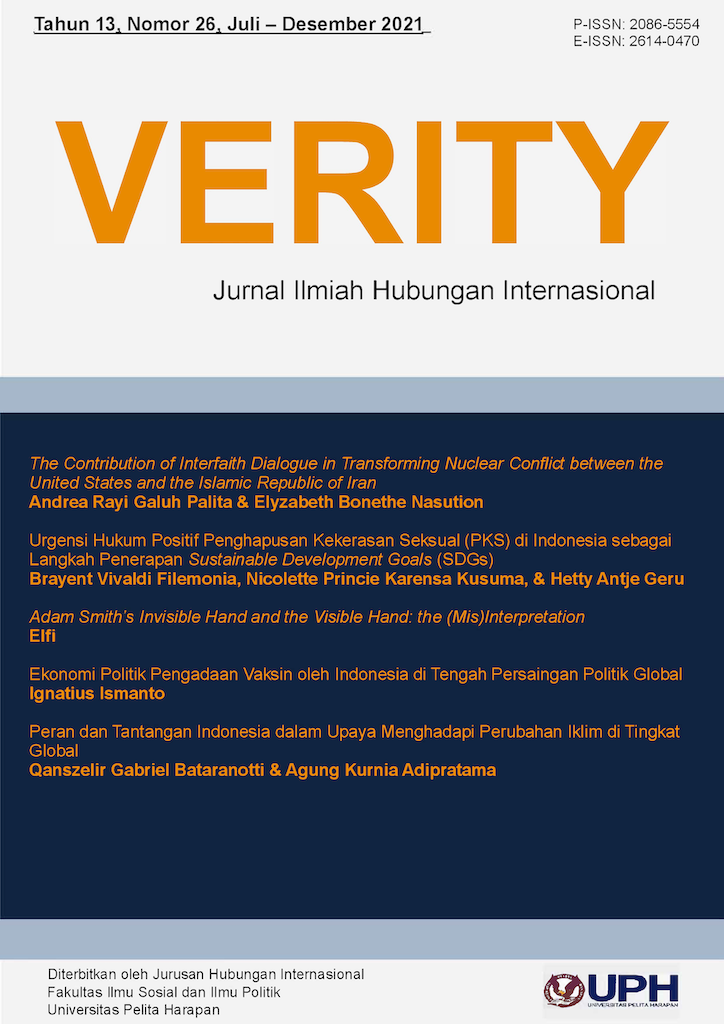Adam Smith's Invisible Hand and the Visible Hand
DOI:
https://doi.org/10.19166/verity.v13i26.5244Λέξεις-κλειδιά:
Adam Smith, invisible hand, government intervention, laissez-faire, visible handΠερίληψη
The invisible hand is one of Adam Smith’s prominent theories. It argues that if individuals are left to pursue their self-interest, it will unintentionally lead to the public good. Scholars have been interpreting the invisible hand from many aspects: some regard it as a strong justification for selfish acts and that it is unethical, another sees it as a perfect competition among small and traditional firms, it is even read in a mystical nuance, and others consider him as a supporter of the laissez-faire economy. New theories are found in response to Smith’s invisible hand. However, some are built on wrong interpretations of the invisible hand. Employing the literature review method, this paper probes three books and three articles, which are selected from ScienceDirect and Google Scholar, aiming to elaborate on how the invisible hand is interpreted and misinterpreted and hopes to provide a clear understanding of what was Smith’s original idea with regards to the role of government. This paper finds that Smith is nowhere close to a laissez-faire figure. He even has an elaborative list of actions government should take to promote the public interest. Further research in other aspects of the invisible hand, i.e., theological and moral perspective, will contribute to a more conclusive comprehension of Smith’s invisible hand.
Bahasa Indonesia Abstract: “Tangan tak terlihat” adalah salah satu dari teori Adam Smith yang menonjol. Teori tersebut menyatakan bahwa jika seseorang mencoba untuk mengejar kepentingan pribadinya, maka akan secara tidak sengaja berujung kepada barang publik. Para peneliti telah mencoba untuk menginterpretasikan “tangan tak terlihat” dari berbagai aspek. Beberapa di antara mereka melihat hal ini sebagai justifikasi yang kuat terhadap tindakan-tindakan egois yang tidak etis. Di sisi lain, beberapa di antara mereka melihat hal ini sebagai sebuah bentuk persaingan sempurna di antara perusahaan-perusahaan kecil dan traditional (tidak jarang dibaca dalam nuansa mistis). Di sisi yang lain lagi, beberapa di antara mereka melihat Adam Smith sebagai pendukung dari konsep ekonomi laissez-faire. Teori-teori baru telah ditelusuri sebagai tanggapan dari teori “tangan tak terlihat” milik Smith. Namun, banyak dari teori tersebut yang dibangun berdasarkan interpretasi yang salah terhadap “tangan tak terlihat”. Dengan menerapkan metode tinjauan Pustaka, naskah ini menelaah tiga buku dan tiga artikel yang dipilih dari ScienceDirect dan Google Scholar dengan tujuan untuk menjelaskan lebih lanjut bagaimana “tangan tak terlihat” diimplementasikan secara tepat dan kurang tepat serta menyediakan pemahaman yang lebih jelas terhadap gagasan orisinil Smith mengenai peran pemerintah. Naskah ini menemukan bahwa teori Smith sangat jauh berbeda dengan konsep ekonomi laissez-faire. Bahkan, Smith memiliki daftar yang elaboratif berisi tindakan yang harus diambil pemerintah untuk mempromosikan kepentingan publik. Penelitian lebih lanjut mengenai aspek-aspek lainnya dari teori “tangan tak terlihat” (seperti pendekatan teologis dan moral) akan berkontribusi terhadap pemahaman yang lebih konklusif terhadap teori Smith.
Αναφορές
BăileÅŸteanu, G., & Lungu, A. L. (2014). The ”˜Invisible Hand’ and the ”˜Social Visible Hand’ in the Economic Mechanism of the Market. Procedia - Social and Behavioral Sciences, 124, 100-106. https://doi.org/10.1016/j.sbspro.2014.02.465
Chandler, Jr., A. D. (1999). The visible hand: The managerial revolution in American business. Harvard University Press.
Farmer, D. J. (2003). Invisible Hand and Visible Management. In Handbook of Organization Theory and Management: The Philosophical Approach (2nd ed., pp. 227-255). Taylor & Francis Group.
Galbraith, J. K. (1987). Economics in Perspective: A Critical History. Houghton Mifflin Company Boston.
Matthews, D. (2000). The Visible Hand? The Economics of Alfred Chandler. Essays in Economic & Business History, 18(1), 163-173.
Mitchell, W. C. (2001). The Old and New Public Choice: Chicago versus Virginia. In W. F. Shughart II & L. Razzolini (Eds.), The Elgar Companion to Public Choice (pp. 3-32). Edward Elgar.
Pack, S. J. (1994). Adam Smith’s Invisible/Visible Hand/Chain/Chaos. In Joseph A. Schumpeter, Historian of Economics: Perspectives on the History of Economic Thought: Selected Papers from the History of Economics Society Conference (pp. 181-195). https://digitalcommons.conncoll.edu/cgi/viewcontent.cgi?article=1023&context=econfacpub
Rosen, H. S. (2002). Public finance (6th ed.). Irwin/McGraw-Hill.
Samuels, W. J. (2011). Erasing the invisible hand: Essays on an elusive and misused concept in economics. Cambridge University Press. https://doi.org/10.1017/CBO9780511835230
Samuelson, P. (1962). American Economic Association Economists and the History of Ideas. The American Economic Review, 52(1), 1-18.
Samuelson, P. A., & Nordhaus, W. D. (2010). Economics (19th ed). McGraw-Hill.
Stiglitz, J. E. (1988). Economics of the Public Sector (2nd ed.). Norton.
West, E. G. (1990). Adam Smith and Modern Economics: From Market Behaviour to Public Choice. Edward Elgar.
Λήψεις
Δημοσιευμένα
Τεύχος
Ενότητα
Άδεια
Authors who publish with this journal agree to the following terms:
1) Authors retain copyright and grant the journal right of first publication with the work simultaneously licensed under a Creative Commons Attribution License (CC-BY-SA 4.0) that allows others to share the work with an acknowledgement of the work's authorship and initial publication in this journal.
2) Authors are able to enter into separate, additional contractual arrangements for the non-exclusive distribution of the journal's published version of the work (e.g., post it to an institutional repository or publish it in a book), with an acknowledgement of its initial publication in this journal.
3) Authors are permitted and encouraged to post their work online (e.g., in institutional repositories or on their website). The final published PDF should be used and bibliographic details that credit the publication in this journal should be included.


